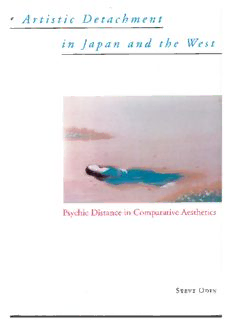
Artistic Detachment in Japan and the West: Psychic Distance in Comparative Aesthetics PDF
Preview Artistic Detachment in Japan and the West: Psychic Distance in Comparative Aesthetics
Artistic Detachment in Japan and the West A r t i s t i c D e t a c h m e n t i n J a p a n a n d t h e We s t Psychic Distance in Comparative Aesthetics STEVE ODIN A University of Hawai‘i Press Honolulu 2001 University of Hawai‘i Press All rights reserved Printed in the United States of America 06 05 04 03 02 01 6 5 4 3 2 1 Library of Congress Cataloging-in-Publication Data Odin, Steve. Artistic detachment in Japan and the west : pyschic distance in comparative aesthetics / Steve Odin. p. cm. Includes bibliographical references and index. ISBN 0–8248–2211–0 (cloth : alk. paper) — ISBN 0–8248–2374–5 (pbk. : alk. paper) 1. Aesthetics, Comparative. 2. Aesthetics, European. 3. Aesthetics, Japanese. I. Title. BH85.O34 2000 111'.85'09—dc21 00–062034 University of Hawai‘i Press books are printed on acid-free paper and meet the guidelines for permanence and durability of the Council on Library Resources. Designed by Chris Crochetière, B. Williams & Associates Printed by The Maple-Vail Book Manufacturing Group Contents Acknowledgments vii Introduction Artistic Detachment as an Intercultural Theme 1 Part One Artistic Detachment East and West 1 Artistic Detachment in Western Aesthetics 27 2 Artistic Detachment in Japanese Aesthetics 99 3 An East-West Phenomenology of the Aesthetic Attitude 170 Part Two Psychic Distance in Literature East and West 4 Psychic Distance in Modern Western Literature 199 5 Psychic Distance in Modern Japanese Literature 214 Glossary 281 References 283 Index of Names 291 v Acknowledgments I wrote this book as a 1994–1995 Fulbright scholar at Tohoku University in Sendai, Japan. I would espe- cially like to thank Professor Tanaka Hideyoshi from the Aesthetics Department as well as Professors Noe Keiichi, Ano Fumio, and Nu- mata Hiroyuki at Tohoku University for their encouragement. Many ideas in this volume have been developed over fifteen years of teach- ing courses on Japanese and comparative aesthetics at the University of Hawai‘i. Among my colleagues in the UH Department of Philos- ophy, I would especially like to thank Professor Arindam Chakrabharti, who has been a great source of information for this work. Among grad- uate students in our Philosophy Department, I would like to thank Brad Parks for his careful reading of my manuscript. Other colleagues at the University of Hawai‘i have been profoundly instrumental in the development of this project, especially Takie Sugiyama Lebra and Valdo H. Viglielmo. Indeed, Professor Viglielmo’s dual expertise in modern Japanese philosophy and modern Japanese literature has guided the direction of this work. I would like to express my indebtedness to Professor Steven Heine, as well, for his valuable comments on this manuscript. Finally, Robert C. Neville, my philosophy adviser at both the undergraduate and graduate levels, has made an important contri- bution to the present work and his insights are cited in the following pages. vii Introduction Artistic Detachment as an Intercultural Theme This book takes up the notion of artistic detachment, or psychic distance, as an intercultural motif for East-West comparative aesthetics. Specifically we will examine the notion of beauty as a func- tion of psychic distance in Western and Japanese aesthetics, including both the philosophical and the literary traditions. On the Western side I underscore the notion of artistic detachment that developed from the revolution in aesthetics initiated by Kant’s much celebrated (as well as much criticized) idea of beauty as a function of disinterested con- templation. On the Eastern side I highlight the Japanese notion of beauty as hidden depths apprehended through artistic detachment, a concept developed both in traditional Zen aestheticism and its refor- mulation in the Kyoto school of modern Japanese philosophy. Insofar as representative philosophers in the Kyoto school adopt an East-West comparative framework rooted in a Japanese Buddhist metaphysics of nothingness, they set forth a theory of disinterested aesthetic contem- plation that synthesizes elements from both the Kantian and Zen Bud- dhist traditions. Furthermore, I endeavor to clarify how artistic detach- ment has been developed as a central motif in “portrait-of-the-artist” novels in Japanese and Western traditions of literary aestheticism. Portrait-of-the-artist novels in both traditions articulate a detachment theory of art in which beauty is a function of an act of disinterested contemplation. Moreover, the artistic detachment motif is related to plot and character development insofar as the protagonist is typically a young artist who cultivates heightened aesthetic consciousness through disinterested contemplation to the point of extreme alienation. Furthermore, artistic detachment is built into the structure of an im- partial narrative that records satori-like epiphanies, or haiku moments of sudden illumination, whereby the hidden depths of ordinary events are disclosed through acts of disinterested contemplation. Ultimately the goal of portrait-of-the-artist novels in both Japanese and Western literature is transmutation of life into art through psychic distance. 1
Description: